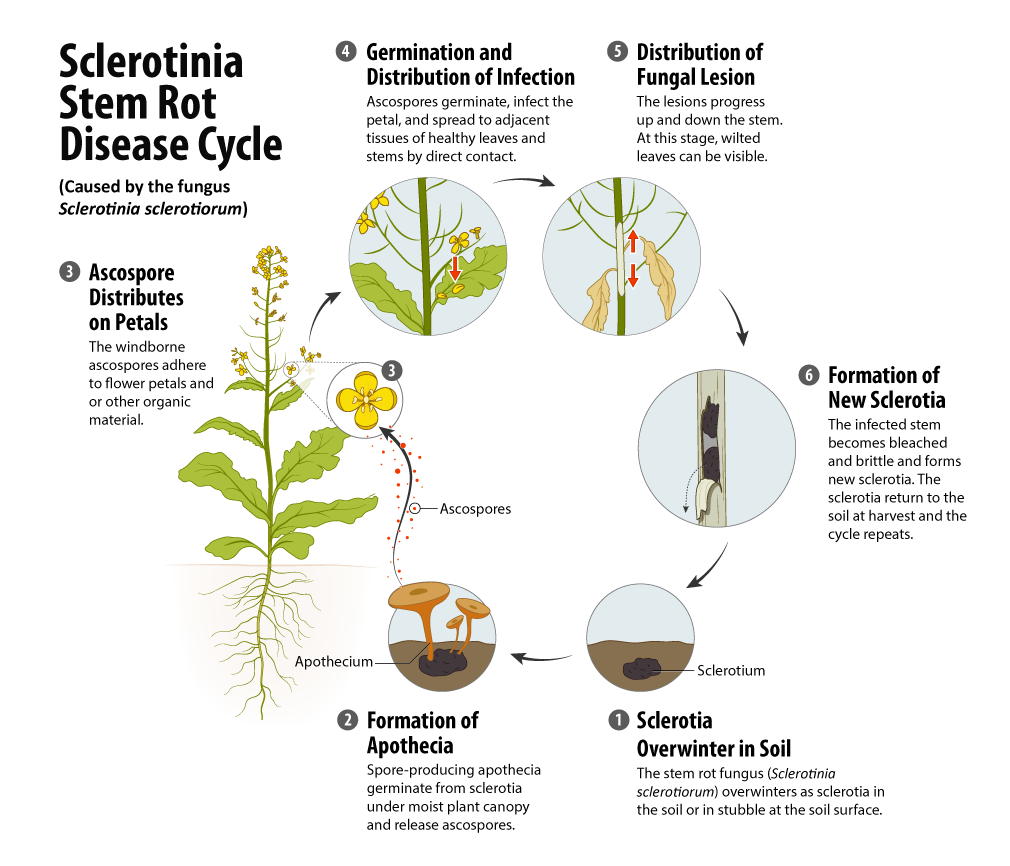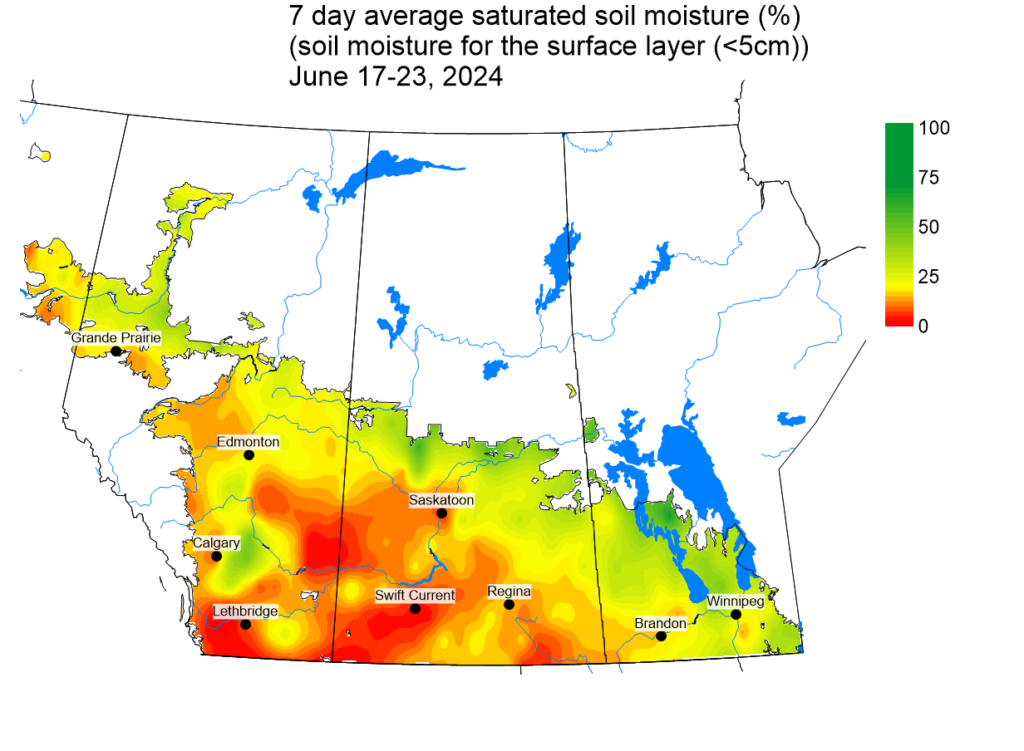June and early July are important months in terms of field crop pathogen and disease development for Prairie farmers. For diseases such as sclerotinia stem rot of canola and ergot of small grain cereals, suitable pathogen development must occur to produce spores before host infection can take place. The pathogens associated with both diseases overwinter as resting bodies known as sclerotia, which are compact masses of hyphae (Figure 1). Germination of stem rot sclerotia to produce the golf-tee shaped apothecia, aka carpogenic germination, requires sufficient soil moisture and moderate temperatures. Typically, germination takes up to three weeks with the occurrence of temperatures that range from 10 to 20oC with soil water potentials of about 0 to 500 kPa, although germination is reduced as kPa increases to >=300-500 kPa (Abawi and Grogan 1975; Boland 1984; Boland and Hall 1988; Clarkson et al. 2004; Hao et al. 203; Teo and Morrall 1985a,b). These conditions typically occur for Prairie crops with adequate rainfall following canopy closure over the soil surface, which helps to buffer temperature and moisture fluctuations.
Soil water (matric) potential is a measure of how closely water is held by soil particles and pores (Datta et al. 2017; Irmak 2019). Soil volumetric water content (VWC) is related to the ratio of soil water volume and the volume of the soil and is expressed in percentages. The relationship between VMC and soil matric potential varies depending on soil texture and is expressed through a soil water characteristic curve for each soil type . When soils approach saturation (0 kPa) the VMC will be up to 45% for clay textured soil, while for sandy soils this value is 30%. Once soil water potential increases above 300 kPa plant root access to water will be increasingly difficult, while for soils overall the permanent wilting point of a plant is generally considered to be reached around 1,500 kPa (Datta et al. 2017).
Soil moisture values, particularly near the soil surface, can impact on sclerotial germination. Figure 2 presents data to show soil moisture levels (averaged for June 17-23) in the top five centimeters of soil in western Canada. Driest soil moisture conditions were observed for western regions of Saskatchewan and eastern regions of Alberta. Soil moisture values were greatest for Manitoba and the Parkland region of Saskatchewan. The data is produced from passive microwave satellite data collected by the Soil Moisture and Ocean Salinity (SMOS) satellite and converted to soil moisture using the SMOS soil moisture processor. The data are produced by the European Space Agency. Satellites are used to sense the strength of radiation emitted from the surface of the earth. There is a strong difference in the signals emitted by dry soil and wet soil. This relationship is used to calculate surface soil moisture using a model that incorporates land cover, vegetation content, surface roughness, soil texture and other factors that influence the satellite sensor. The satellite collects data every one to three days over Canada (Satellite Soil Moisture – agriculture.canada.ca).
Prairie canola growth stages for 2024 are variable depending on the Province, region, and seeding date. In many regions crops are moving from the rosette stage to stem elongation and are beginning to flower. For wetter regions, conditions have been favourable for germination of sclerotia and production of apothecia over the last 1-2 weeks. However, recent rains in drier areas will help to initiate sclerotial germination and eventual production of apothecia over the next 2-3 weeks. As of June 23, the need to scout fields for apothecia of the stem rot fungus and/or to assess in-field risk is low to moderate, although the risk is higher in regions where moisture conditions have been increased over the last 2-3 weeks, e.g. Manitoba. Scouting is especially important where crop canopies have covered the soil surface for at least 2-3 weeks. In 2006, the Canola Council of Canada and Agriculture and Agri-Food Canada co-developed a canola disease identification card that includes examples of typical stem rot pathogen apothecia along with other fungal fruiting structures that are not stem rot apothecia.
In these higher risk areas in-crop scouting for apothecia and the use of available stem rot risk assessment tools may be needed over the next 1-3 weeks as part of fungicide use decisions. Tools such as the Spornado spore trap and petal testing services (service 1 and service 2) can provide guidance related to the level of sclerotinia inoculum and stem rot risk as the crop starts flowering. Note these need to be combined with other risk tools to provide a complete picture of stem rot risk in relation to host, pathogen and environment factors, i.e. the disease triangle. If fungicides are being considered, accounting for the most common crop growth stage in a field should be considered to help guide the timing(s) used. Fortunately, most fungicide products have a window from 20-50% bloom, which represents a range of growth stages. Note available risk assessment tools will provide guidance related to stem rot risk and whether a fungicide is needed from 20-50% bloom.
On June 26, 2024, a new web-based tool from the Canola Council of Canada was recently announced that considers host, pathogen and weather related stem rot risk factors as well as a component that evaluates ROIs based on input costs, projected yields and commodity price. More information on the tool can be found at the Canola Council of Canada, along with the online tool itself.
References
Abawi, G.S., and R.G. Grogan. 1975. Source of primary inoculum and effects of temperature and moisture on infection of beans by Whetzelinia sclerotiorum. Phytopathology 65: 300-309.
Boland, G.J. 1984. Epidemiology and management of diseases caused by Sclerotinia sclerotiorum in whitebean and soybean. Ph. D. thesis, Univ. of Guelph, Guelph, Ontario. 245 pp.
Boland, G. J., and Hall, R. 1988. Epidemiology of Sclerotinia stem rot of soybean in Ontario. Phytopathology 78:1241-1245.
Clarkson, J. P., Phelps, K., Whipps, J. M., Young, C. S., Smith, J. A., and Watling, M. 2004. Forecasting Sclerotinia disease on lettuce: Toward developing a prediction model for carpogenic germination of sclerotia. Phytopathology 94:268-279.
Datta, S., Taghvaeian, S., and Stivers, J. 2017. Understanding Soil Water Content and Thresholds for Irrigation Management. Oklahoma Cooperative Extension Service, BAE-1537, June 2017. Division of Agricultural Sciences and Natural Resources, Oklahoma State University.
Grogan, R.G., and Abawi, G.S. 1975. Influence of water potential on growth and survival of Whetzelinia sclerotiorum. Phytopathology 65: 122-128.
Hao, J. J., Subbarao, K. V., and Duniway, J. M. 2003. Germination of Sclerotinia minor and S. sclerotiorum sclerotia under various soil moisture and temperature combinations. Phytopathology 93:443-450.
Irmak, S. 2019. Soil water content – and soil matric potential-based irrigation trigger values for different soil types. Institute of Agriculture and Natural Resources, CropWatch, University of Nebraska-Lincoln. https://cropwatch.unl.edu/2019/SWC-SMP-irrigation-trigger-values.
Teo, B. K., and Morrall, R. A. A. 1985a. Influence of matric potentials on carpogenic germination of sclerotia of Sclerotinia sclerotiorum. 1. Development of an inclined box technique to observe apothecium production. Can. J. Plant Pathol. 7:359-364.
Teo, B.K., and R.A.A. Morrall. 1985b. Influence of matric potentials on carpogenic germination of sclerotia of Sclerotinia sclerotiorum. II. A comparison of results obtained with different techniques. Can. J. Plant Pathol. 7: 365-369.

Figure 1. Disease cycle of sclerotinia stem rot of canola. Courtesy of Taryn Dickson, Resource Manager, Crop Production and Innovation and the Canola Council of Canada.


